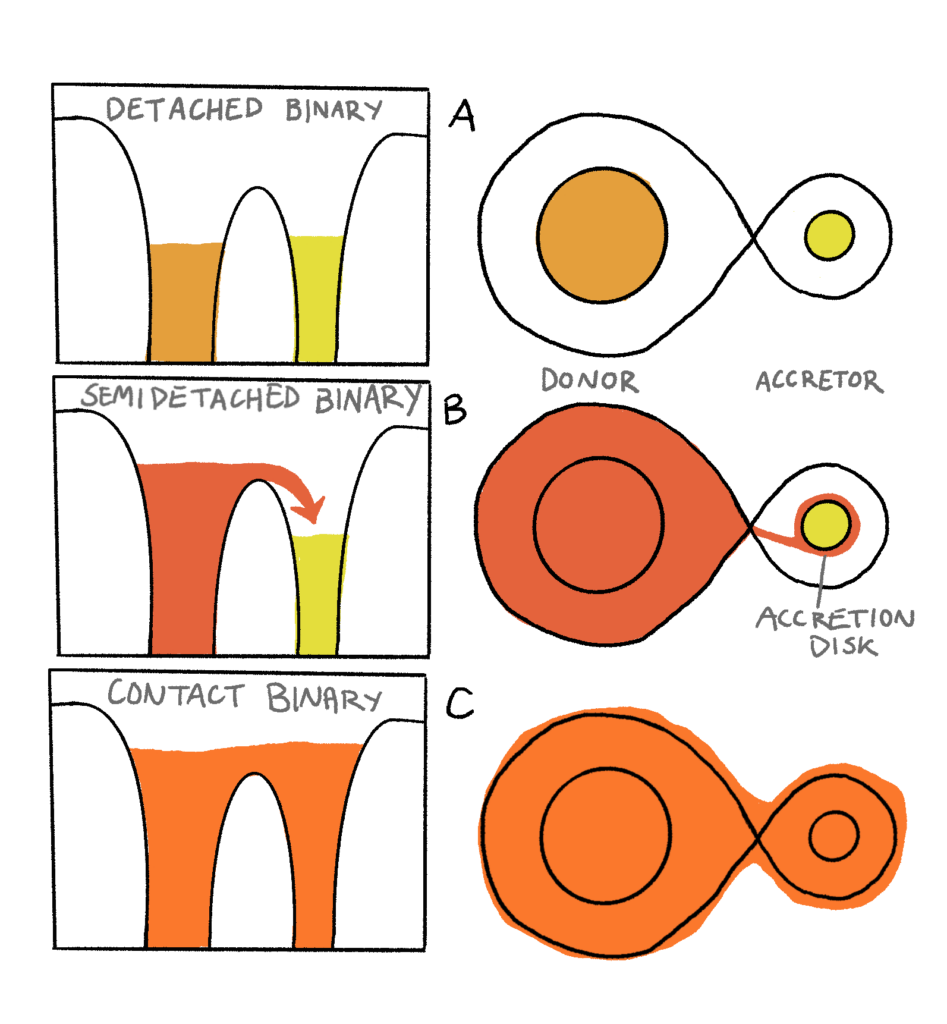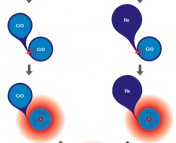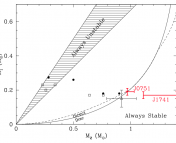Title: Expansion of accreting main-sequence stars during rapid mass transfer
Authors: Mike Y. M. Lau, Ryosuke Hirai, Ilya Mandel, Christopher A. Tout
First Author’s Institution: Heidelberger Institut für Theoretische Studien, Schloss-Wolfsbrunnenweg 35, 69118 Heidelberg, Germany
Status: Currently only pre-print available
In our universe, most stars live in binaries. These stars live together, orbiting around each other, evolving and influencing each other’s lives. For many stars, this can be a tumultuous relationship with periods of mass transfer, altering the stars’ lives from the typical single star evolution from a main sequence star to a red giant to a stellar remnant. Mass transfer allows stars to grow and shrink in mass through their evolution, changing their identities and speeding up or slowing down their evolution, and can be the cause for stars going supernova.
Mass transfer occurs when one of the stars in the binary expands in radius during its evolution. If this expansion pushes the outside layers of the star beyond the gravitational influence of the star, the outer layers will be pulled from the expanded donor star onto the other accreting star in the binary. The gravitational influence of each star is called the Roche lobe, illustrated in Figure 1.

As common as mass transfer is in the lives of stars, there are a lot of unknowns about mass transfer processes. Astronomers make simulations of these stars, modeling mass transfer to try and better understand these unknowns. Simulating a fully accurate model of these processes requires many computational resources to model the hydrodynamic processes in all dimensions, and so models always make some simplifying assumptions.
One big simplifying assumption is how much of the donor star’s mass can be packed onto the accreting star. Previous models assumed that the accreting star does not change with time when accepting mass from the donor star. However, today’s authors are actually able to investigate how the properties of the accreting star change through the mass transfer period using a stellar evolution code (MESA).
The authors show that how the accretor’s mass and radius respond to mass transfer depends on two timescales: the thermal timescale of the accretor – this is the timescale on which the accretor can radiate away all of its thermal energy; and the timescale of the accretion – this is the rate of mass transfer from the donor to the accretor. The thermal timescale of the accreting star is generally much longer than the mass transfer timescale, meaning that during mass transfer the accreting star is fed mass much more quickly than it can ‘swallow’ it, or have it thermally cool and settle onto the star. However, the accreting star can store this accreted matter in an envelope around it, stuffing it in its cheeks much like a hamster, as long as this does not spill over the edge of the Roche Lobe, hence why the authors coin these stars as “hamstars”. This makes the accreting star grow in radius and cool much like a typical main sequence star becoming a red giant, as shown in figure 2. As the star’s luminosity increases as it accretes more and more, its thermal timescale decreases, and it can more quickly radiate the energy of accreting mass and ‘swallow’ the matter, shrinking again from the expanded radius, having grown several times in mass.

How much the radius expands during mass transfer changes the fraction of mass lost by the donor that is added to the accretor. This is called the accretion efficiency, and is often assumed to be an arbitrary constant. With the authors’ prescription for the change in radius of the accretor, they describe a new way for calculating the accretion efficiency considering the accretor’s expansion. This depends on the initial mass of the accreting star, and is found to be higher than typical assumptions for low-mass (less than 15 solar mass) accreting stars, and lower for high-mass (more than 20 solar mass) stars.
This accretion efficiency determines how much of the mass accreted actually makes it onto the accreted star, versus how much might be lost during mass transfer. While low-mass stars can pack a lot of accreting matter in their hamster cheeks, high-mass stars have a lower limit for how much matter they can chew. These higher-mass accreting stars make up observed populations of x-ray binaries and the progenitors of pairs of black holes and/or neutron stars. Compared to current models, the author’s prescription for accretion efficiency is in better agreement with the observed population of x-ray binaries, and predicts fewer merging black hole binaries that could be observed with gravitational waves, something we could investigate further with more observations.
While today’s paper considers the accretor’s response to mass transfer (pinning down the similarities between stars and rodents), it does not account for stars spinning or mass loss. If a star is spinning fast, it could limit how much the accreting star can expand. Some mass can also be swept away by stellar winds, meaning there isn’t a 100% transfer of mass from one star to the other. Future work is needed to incorporate these additional factors, before we can look up into the cosmos for a great hamstar hunt!
Astrobite edited by Lucie Rowland
Featured image credit: Nikolett Emmert / NASA, CXC, Melissa Weiss (CXC), adapted by Storm Colloms




